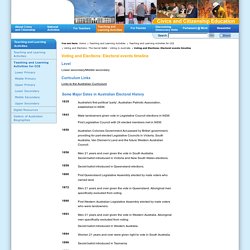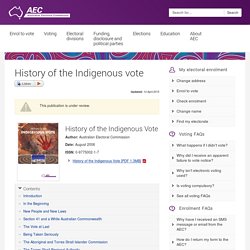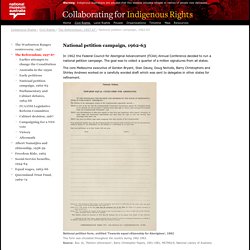

History of Voting: 24/05/2016, Behind the News. On July the 2nd all Australians over the age of 18 will have the right to vote.

But it hasn't always been that way. Take a look. Twas the night before the election and all through the house, not a creature was stirring. Except for one girl who was having a bit of a sook. VOTER: I don't care. GHOST OF VOTING PAST: I am the ghost of voting past. VOTER: That voice is super annoying, can you cut it out? GHOST OF VOTING PAST: Okay, fine. VOTER: Okay Mr 'Ghost of Voting Past', why should I care about voting? GHOST OF VOTING PAST: Well, voting gives you a say about what happens in Australia and you should be happy you even get to vote. VOTER: Of all the cool things we could do with time travel you're making me vote. GHOST OF VOTING PAST: Yes. VOTER: Excuse me, I'd like to vote. VOTING ATTENDANT: Give me a break, voting is not for women. GHOST OF VOTING PAST: Sucks doesn't it, things weren't so good for women back then.
That's right. That's why, in the late 1800s, many women started to demand change. Voting and Elections: Electoral events timeline. Level Lower secondary/Middle secondary Curriculum Links Links to the Australian Curriculum The information on this timeline was adapted from Fact Sheet 17, 'Australian Electoral History', published by the Electoral Education Centre, Canberra.

A detailed timeline is provided on the Discovering Democracy School Materials Project CD ROM, 'Stories of Democracy'. Think about it. Voting rights for Aboriginal people - Creative Spirits. Aboriginal ‘Vote’ poster.

This poster is part of a series designed specifically for and in consultation with remote area communities by Aboriginal designers in the late 1980s to encourage Aboriginal citizens to become actively involved and to exercise their right to vote [1]. Early voting rights The path towards voting rights began in 1850 with the self-regulation of the Australian colonies and the granting of the vote to all adult male British subjects over 21 in South Australia (1856), Victoria (1857), New South Wales (1858) and Tasmania (1896). This included Aboriginal men.[7] In 1894 South Australia, which then included the Northern Territory, made laws which allowed all adults to vote, including all women and therefore all Aboriginal women [5]. Very few Aborigines knew their rights so very few voted. 50th anniversary of the Indigenous right to vote. Updated: 19 March 2012 The AEC is marking 2012 as the Year of Enrolment to commemorate the 50th anniversary of the Indigenous right to vote in federal elections.

In the Year of Enrolment, the AEC will strengthen its ongoing efforts to promote enrolment to Indigenous Australians to increase their electoral participation. In 1962, the Commonwealth Electoral Act 1918 was amended to give Indigenous people the right to enrol and vote in federal elections. The AEC's Indigenous Electoral Participation Program (IEPP) aims to increase Indigenous electoral knowledge, enrolment and participation and reduce informal voting. A 50th anniversary calendar, featuring Indigenous community leaders and a short DVD on the history of the Indigenous vote, have been specially developed to promote enrolment and voting.
Eligible Australian citizens, 18 years or over, can enrol to vote, change their address or check their enrolment details through this website. Quick facts. History of the Indigenous vote. Updated: 14 April 2015 This publication is under review.

Introduction History of the Indigenous Vote traces the history of Indigenous people's right to vote in Australia. The story includes gaining the vote, along with other Australians, in the mid 1800s, losing the vote at Federation, and active participation in the electoral process in modern day Australia. In recent times democratically elected Indigenous organisations have been established to specifically represent the interests of Aborigines and Torres Strait Islanders. This booklet documents changes in Indigenous voting rights at federal and state/territory levels. Marking 50 years of Indigenous federal voting. (Transcript from World News Australia Radio) The year is 1963.

The Beatles are at the top of the charts in Australia and overseas, and the civil rights movement in the United States is gaining momentum. In Australia, a federal election on the last day of November sees Sir Robert Menzies' Coalition government returned with an increased majority. That election also marked a major turning point for Australia's Indigenous people.
Peggy Giakoumelos reports. (Click on audio tab above to hear full item) "I am going into office with one thing clearly on my mind, and that is to make and keep Australia safe. " So said Sir Robert Menzies, Australia's longest serving Prime Minister. Collaborating for Indigenous Rights 1957-1973. In 1962 the Federal Council for Aboriginal Advancement (FCAA) Annual Conference decided to run a national petition campaign.

The goal was to collect a quarter of a million signatures from all states. The core Melbourne executive of Gordon Bryant, Stan Davey, Doug Nicholls, Barry Christophers and Shirley Andrews worked on a carefully worded draft which was sent to delegates in other states for refinement. National petition form, entitled 'Towards equal citizenship for Aborigines', 1962This form was circulated throughout the country during 1962-1963.Source: Box 16, 'Petition referendum', Barry Christopher Papers, 1951-1981, MS7992/8, National Library of Australia.